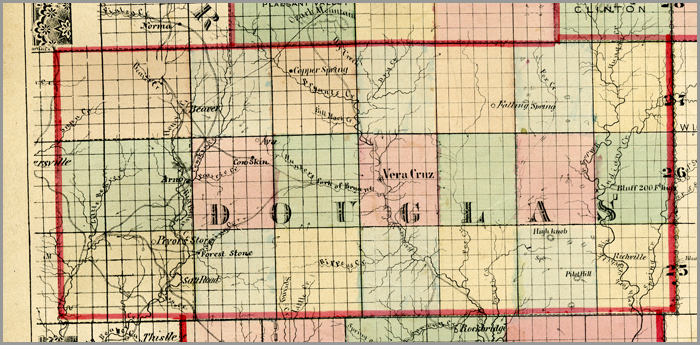Douglas County, Missouri

- Formed: October 19, 1857
- County Population 1860: 2,429
- Slave Population 1860: NA
- Civil War Engagements
-Battle of Clark’s Mill, or the First Battle of
Vera Cruz, November 7, 1862
Image courtesy of Wilson’s Creek National Battlefield
Douglas County, Missouri, was traditionally Osage territory. However, the Osage were eventually pushed out of the area after the Louisiana Purchase when many non-Native American explorers and settlers moved west. In 1818, famous explorer Henry R. Schoolcraft passed through the area. The county’s earliest settlers came from Kentucky or Tennessee. James Anderson Wilson and his wife, Kentucky Natives, were among the first permanent non-Native American settlers and moved to Douglas County from Indiana in 1840. Another prominent settler, William J. Turner, established the first store in the county. Most early settlers subsisted by hunting wild game, planting tobacco, corn, and limited amounts of cotton. Many settlers owned sheep to use for wool.
Douglas County is located near the North Fork and Bryant’s Fork of the White River, which have many tributaries. These include: Big and Little Beaver Creeks, Hungry, Indian, and Cowskin Creeks, and Dry, Brush, and Rippee Streams. The soil is very fertile and suitable for growing corn, tobacco, and cotton. Douglas County also has abundant timber resources, including oak, hickory, and sycamore, as well as limestone for building. Douglas County was officially formed on October 19, 1857 out of part of Ozark County. It was named after well-known politician Stephen A. Douglas, who ran against Lincoln for the Senate and the Presidency. The first county seat was at Vera Cruz.
When the Civil War began less than four years after the county’s formation, Missouri Governor Claiborne Jackson appointed General J.H. McBride to command and control the Douglas County area and put down Union supporters. However, a large number of local men, led by John Sevier Upshaw, defied the governor and formed the Douglas County Home Guard, which supported the Union Army. They used the Vera Cruz courthouse as their headquarters for most of the war’s duration. The Douglas County Home Guard soon contacted Union Colonel Sempronius Hamilton Boyd to help, who replied that help would be sent as soon as possible. He commanded the Home Guard to keep the county from Confederate control until Union troop could arrive. The Douglas County Home Guard was very successful in this endeavor.
There were no major battles fought within Douglas County boundaries, but there were several small battles and skirmishes. In 1861, the Douglas County Home Guard was involved with a skirmish near present-day Rome, Missouri. Several Douglas County residents also fought in the Battle of Wilson’s Creek in August 1861 in Greene County. In March, 1862, there were several skirmishes near Vera Cruz. In November, 1862, the Battle of Clark’s Mill, or the First Battle of Vera Cruz, took place between John Q. Burbridge’s Confederate troops and Union troops under Hiram E. Barstow. The purpose was to destroy all mills, blockhouses, and other structures in this area that could aid the Union Army. Once the Union soldiers ran out of ammunition they surrendered, resulting in a Confederate victory. The Battle of Wilson’s Mill, or the Second Battle of Vera Cruz, took place on November 3, 1864 between Union troops under Moses Lock Alsup and Confederate troops in the area. The battle resulted in a Confederate retreat into Arkansas. During the Civil War, more casualties occurred because of bushwhackers and guerrilla warfare than because of any actual battles.
In February 1864, parts of Webster and Taney Counties were added to Douglas County. Vera Cruz was no longer centrally located, so the county seat was moved to Arno in 1869. The third and final county seat was established at Ava in 1871. Douglas County strove to rebuild itself after the war, and with the help of railroad construction in the late 1800s, eventually prospered once again.
 Browse all collections in Douglas County
Browse all collections in Douglas County
- Consulted:
- Bessie J. Selleck, The Early Settlers of Douglas County, Missouri (Berkeley, CA: The Professional Press, 1952).
- Douglas County, Missouri: History and Families. History Book Committee of the Douglas County Historical and Genealogical Society (Paducah, KY: Turner Publishing Company, 1996).
- “The Battle of Clark’s Mill”, Bryant Watershed Project, West Plains, Missouri, accessed on 3 November 2010, http://www.watersheds.org/history/battle.htm












